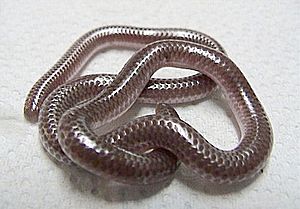Rena dulcis facts for kids
The Texas blind snake, also known as the Texas slender blind snake or Texas threadsnake, is a unique type of snake found in the Southwestern United States and northern Mexico. It's part of a snake family called Leptotyphlopidae. This interesting snake has three recognized types, or subspecies.
Quick facts for kids Rena dulcis |
|
|---|---|
 |
|
| Conservation status | |
| Scientific classification | |
| Genus: |
Rena
|
| Species: |
dulcis
|
| Synonyms | |
|
|
Contents
What Does the Texas Blind Snake Look Like?
The Texas blind snake looks a lot like a shiny earthworm. It has a pinkish-brown color and its scales are very smooth and shiny. It doesn't appear to have body segments like an earthworm.
Its eyes are tiny, just two dark dots hidden under its head scales. The mouth is small and has an underbite. Adult snakes can grow to about 27 centimeters (11 inches) long, including their tail.
How Does the Texas Blind Snake Behave?
This snake spends most of its life underground in loose soil. It usually only comes out to find food or when its home gets flooded by rain. People often find them after spring rains and think they are earthworms.
If you pick one up, it will wiggle a lot. It might try to poke you with the tip of its tail. This is completely harmless and just a way for the snake to try and scare you. Its mouth is too small to bite a human.
Interestingly, these snakes have a special relationship with eastern screech owls. The owls sometimes carry live Texas blind snakes back to their nests. The snakes then help clean the nest by eating tiny bugs that might bother the baby owls.
What Does the Texas Blind Snake Eat?
The Texas blind snake mainly eats the young (larvae) of termites and ants.
Life Cycle and Reproduction
The Texas blind snake is oviparous, which means it lays eggs.
Where Does the Texas Blind Snake Live?
You can find the Texas blind snake in the southwestern United States and northern Mexico. In the USA, it lives in parts of Kansas, Oklahoma, Texas, New Mexico, and Arizona. In northern Mexico, it has been seen in states like Chihuahua, Coahuila, and Tamaulipas.
Is the Texas Blind Snake in Danger?
It's very hard to count how many Texas blind snakes there are in the wild. This is because they spend so much time hidden underground. However, like many other animals in Texas, these snakes can be harmed by red imported fire ants.
Types of Texas Blind Snakes (Subspecies)
There are three recognized types of Texas blind snakes:
- Rena dulcis dulcis
- Rena dulcis rubellum
- Rena dulcis supraorbicularis
See also
 In Spanish: Rena dulcis para niños
In Spanish: Rena dulcis para niños


